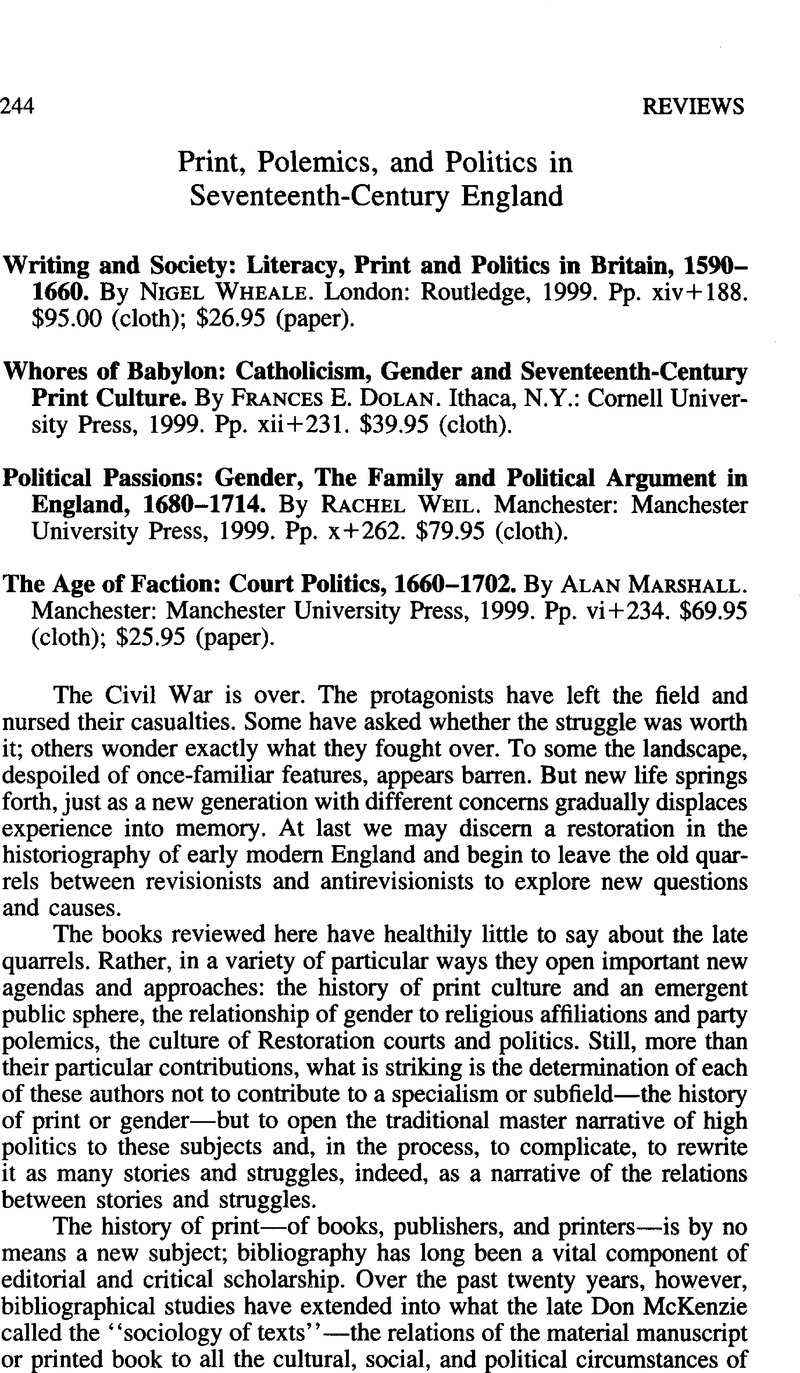Published online by Cambridge University Press: 10 May 2013

1 McKenzie, Don F., Bibliography and the Sociology of Texts (London, 1986)Google Scholar.
2 Darnton, Robert, “What Is the History of Books?” Daedalus 3 (1982): 65–83Google Scholar.
3 Eisentein, Elizabeth, The Printing Press as an Agent of Change: Communications and Cultural Transformations in Early Modern Europe (Cambridge, 1979)Google Scholar.
4 Johns, Adrian, The Nature of the Book: Print and Knowledge in the Making (Chicago, 1998)CrossRefGoogle Scholar.
5 Watt, Tessa, Cheap Print and Popular Piety, 1550-1640 (Cambridge, 1991)Google Scholar; Raymond, Joad, The Invention of the Newspaper: English Newsbooks, 1641–1649 (Oxford, 1996)Google Scholar; Freist, Dagmar, Governed by Opinion: Politics, Religion, and the Dynamics of Communication in Stuart London, 1637–1645 (London, 1997)Google Scholar Johns, Nature of the Book; Clegg, Cyndia, Press Censorship in Elizabethan England (Cambridge, 1997)CrossRefGoogle Scholar; Ginzburg, Carlo, The Cheese and the Worms: The Cosmos of a Sixteenth-Century Miller (London, 1980)Google Scholar; Sharpe, K., Reading Revolutions: The Politics of Reading in Early Modern England (New Haven, 2000)Google Scholar.
6 Cressy, David, Literacy and the Social Order (Cambridge, 1980)CrossRefGoogle Scholar.
7 See Sharpe, K. and Zwicker's, Steven N. volume on Writing Readers in Early Modern England, (Cambridge, in press)Google Scholar.
8 See Clegg, Press Censorship.
9 Capp, Bernard, The World of John Taylor the Water Poet, 1578–1653 (Oxford, 1994)CrossRefGoogle Scholar. Taylor subverts any simple categories of elite or popular: he collected his works and, according to Drummond of Hawthornden, Taylor, one of the king's watermen, was much admired by James I.
10 See, too, Veevers, Erica, Images of Love and Religion: Queen Henrietta Maria's Court Entertainments (Cambridge, 1989)Google Scholar.
11 Note Dolan's important general observation: “A social order that depends on both heterosexuality and misogyny is a social order divided within itself” (Dolan, , Whores of Babylon, p. 131Google Scholar).
12 See too Weil, Rachel, “‘If I did say so, I lyed’: Elizabeth Cellier and the Construction of Credibility in the Popish Plot Crisis,” in Political Culture and Cultural Politics in Early Modern England, ed. Amussen, Susan and Kishlansky, Mark (Manchester, 1995), pp. 189–212Google Scholar.
13 See Perry, Ruth, The Celebrated Mary Astell: An Early English Feminist (Chicago, 1986)Google Scholar.
14 See Hunt, Lynn, The Family Romance of the French Revolution (Berkeley, 1992)Google Scholar.
15 See Bowers, Toni, “Queen Anne Makes Provision,” in Refiguring Revolutions: Aesthetics and Politics from the English Revolution to the Romantic Revolution, ed. Sharpe, Kevin and Zwicker, Steven N. (Berkeley, 1998), pp. 57–74Google Scholar, and The Politics of Motherhood: British Writing and Culture, 1680-1760 (Cambridge, 1996)Google Scholar. For these images of Anne, see Huntington Library, Richard Bull Granger collection of engravings, vol. 23.
16 Schama, Simon, “The Domestication of Majesty: Royal Family Portraiture, 1500-1800,” in Art and History: Images and Their Meaning, ed. Rotberg, Robert I. and Rabb, Theodore K. (Cambridge, 1989), pp. 155–83Google Scholar.
17 Staves, Susan, Married Women's Separate Property in England, 1660-1833 (Cambridge, 1990)CrossRefGoogle Scholar.
18 The politics of these memories awaits a full study, but see Kenyon, John P., Revolution Principles (Cambridge, 1977), chap. 5CrossRefGoogle Scholar.
19 Weil, Compare, Political Passions, “political life ran as much on credit … as did the economy” (p. 193)Google Scholar.
20 See Sharpe, K., Remapping Early Modern England: The Culture of Seventeenth Century Politics (Cambridge, 2000)Google Scholar. Weil observes that “political dilemmas could be better dealt with when recast as dramas” (Political Passions, p. 232).